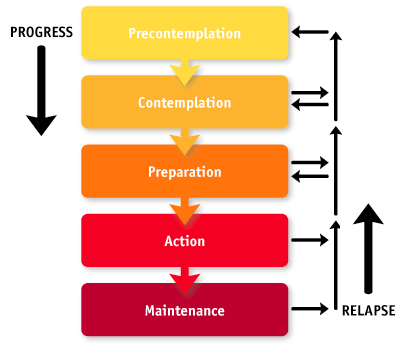
The 5 Stages of Change Model is a very useful framework that describes the series of stages we go through to change our lifestyle habits. The critical assumption that underpins this model is that behavioral changes do not happen in one step, but through a series of distinct, predicable stages. Just realizing the stage of change you’re in may be helpful for you to succeed.
While this model was originally developed in the 1970’s to better understand how smokers are able to give up their addiction to cigarettes, it has since been used to understand changing just about any type of behavior. For the purposes of this article, eating unhealthy foods, or not exercising are the habits we are trying to change.
1) Precontemplation
People in this stage haven’t even thought about making any change to their habits and don’t recognize that they have a problem. They may be pessimistic about their ability to make change, or even deny the negative effects of their existing lifestyle habits. They pick and choose information that helps confirm their decision not to exercise, or eat better.
It’s difficult to reach, or help people in the precontemplation stage, because as they see it, there is no problem. It may take an emotional trigger, or event of some kind that can snap people out of their denial. It’s highly likely if you are taking the time to read this article, you are not in this stage.
2) Contemplation
During this stage, you are weighing the pros and cons, effort, time, finances etc. and benefits of lifestyle modification. You are contemplating whether it’s something that will be worth it. People can remain in this stage for years without preparing to take the next step forward.
I think setting very powerful, motivating goals and visualising your results can be very helpful for someone in the contemplative stage. If you can identify new ways that making a change will benefit you, the benefits will begin to outweigh the costs. We tend to seek pleasure and avoid pain, so the more pleasure you can envision the more likely you will move on.
3) Preparation
People in the preparation stage have decided to change their negative habits. Congratulations if you’re in this category! You may have just set up an appointment with a personal trainer, nutritionist, or other fitness professional, purchased a fitness program, or started a gym membership.
4) Action
The action stage is the process of changing your lifestyle, whether you are exercising more consistently, or eating healthier. Individuals in this stage are at the greatest risk of relapse, so it’s key to leverage any techniques you can to stay motivated.
5) Maintenance
This is the stage of successful, sustained lifestyle modification. If you have been exercising for years consistently and have developed positive habits into your lifestyle, then you are in the maintenance stage.
A lot of people tend to bounce between the contemplation, preparation and action stages, most people are “yoyo” dieters and exercisers. I think one way to prevent this yoyo effect from happening is to make small changes in your habits that over time create something meaningful.
In addition, yoyo dieters and exercisers should understand that maintaining physical fitness and changing fitness are two totally different paths that require different approaches. It’s not that difficult to maintain a given level of physical fitness just by remaining consistent (unless you are at a very high level). It’s very difficult, however, to prepare and take action to change your body. Our bodies are resistant to change, so trying to change them takes a MASSIVE effort that requires a substantial commitment, both mental and physical. Once you’ve changed your body, you can coast without losing that fitness level. It’s a lot better to cut back on exercise and maintain what you’ve gained then to stop completely. Quitters never win.
I hope these 5 stages of change are a helpful framework for you to reference when you are looking to make some type of change in your life.
Also remember that if you ‘fall off the wagon’ you don’t have to go back to the very beginning. For example if you stall at the action stage go back to the preparation, not as far back as contemplation. There will always be stumbling blocks, mental, physical, environmental etc.. the thing to remember is they stumbling blocks not a stop sign.
So, that concludes my article, but if you have any questions please put them in the comments box and together we can all be the best version of ourselves.
Stay hungry.
